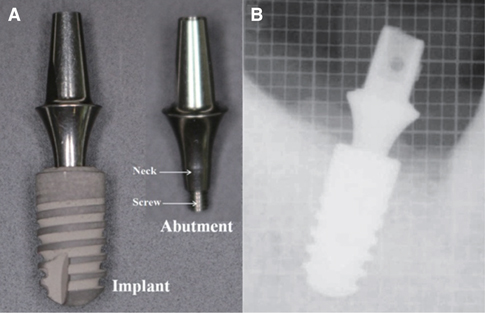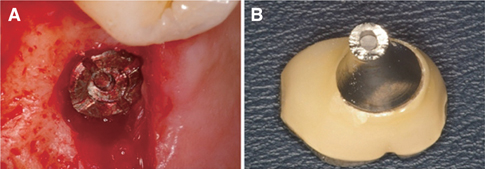J Adv Prosthodont.
2015 Dec;7(6):423-430. 10.4047/jap.2015.7.6.423.
Long-term cumulative survival and mechanical complications of single-tooth Ankylos Implants: focus on the abutment neck fractures
- Affiliations
-
- 1Department of Prosthodontics, Hallym University School of Medicine, Hallym University Sacred Heart Hospital, Anyang, Republic of Korea. hyewonshim@hallym.or.kr
- 2Department of Oral and Maxillofacial Surgery, Hallym University School of Medicine, Hallym University Sacred Heart Hospital, Anyang, Republic of Korea.
- KMID: 2176616
- DOI: http://doi.org/10.4047/jap.2015.7.6.423
Abstract
- PURPOSE
To evaluate the cumulative survival rate (CSR) and mechanical complications of single-tooth Ankylos(R) implants.
MATERIALS AND METHODS
This was a retrospective clinical study that analyzed 450 single Ankylos(R) implants installed in 275 patients between December 2005 and December 2012. The main outcomes were survival results CSR and implant failure) and mechanical complications (screw loosening, fracture, and cumulative fracture rate [CFR]). The main outcomes were analyzed according to age, sex, implant length or diameter, bone graft, arch, and position.
RESULTS
The 8-year CSR was 96.9%. Thirteen (2.9%) implants failed because of early osseointegration failure in 3, marginal bone loss in 6, and abutment fracture in 4. Screw loosening occurred in 10 implants (2.2%), and 10 abutment fractures occurred. All abutment fractures were located in the neck, and concurrent screw fractures were observed. The CSR and rate of screw loosening did not differ significantly according to factors. The CFR was higher in middle-aged patients (5.3% vs 0.0% in younger and older patients); for teeth in a molar position (5.8% vs 0.0% for premolar or 1.1% for anterior position); and for larger-diameter implants (4.5% for 4.5 mm and 6.7% for 5.5 mm diameter vs 0.5% for 3.5 mm diameter) (all P<.05).
CONCLUSION
The Ankylos(R) implant is suitable for single-tooth restoration in Koreans. However, relatively frequent abutment fractures (2.2%) were observed and some fractures resulted in implant failures. Middle-aged patients, the molar position, and a large implant diameter were associated with a high incidence of abutment fracture.
Keyword
MeSH Terms
Figure
Cited by 2 articles
-
Digital evaluation of axial displacement by implant-abutment connection type: An in vitro study
Sung-Jun Kim, KeunBaDa Son, Kyu-Bok Lee
J Adv Prosthodont. 2018;10(5):388-394. doi: 10.4047/jap.2018.10.5.388.Sealing capability and marginal fit of titanium versus zirconia abutments with different connection designs
Nazmiye Şen, Ibrahim Bülent Şermet, Nezahat Gürler
J Adv Prosthodont. 2019;11(2):105-111. doi: 10.4047/jap.2019.11.2.105.
Reference
-
1. Albrektsson T, Brånemark PI, Hansson HA, Lindström J. Osseointegrated titanium implants. Requirements for ensuring a long-lasting, direct bone-to-implant anchorage in man. Acta Orthop Scand. 1981; 52:155–170.2. Romeo E, Lops D, Margutti E, Ghisolfi M, Chiapasco M, Vogel G. Long-term survival and success of oral implants in the treatment of full and partial arches: a 7-year prospective study with the ITI dental implant system. Int J Oral Maxillofac Implants. 2004; 19:247–259.3. Adell R, Lekholm U, Rockler B, Brånemark PI. A 15-year study of osseointegrated implants in the treatment of the edentulous jaw. Int J Oral Surg. 1981; 10:387–416.4. Goodacre CJ, Kan JY, Rungcharassaeng K. Clinical complications of osseointegrated implants. J Prosthet Dent. 1999; 81:537–552.5. Tagger-Green N, Horwitz J, Machtei EE, Peled M. Implant fracture: a complication of treatment with dental implants--review of the literature. Refuat Hapeh Vehashinayim. 2002; 19:19–24. 686. Bozkaya D, Müftü S. Mechanics of the tapered interference fit in dental implants. J Biomech. 2003; 36:1649–1658.7. Merz BR, Hunenbart S, Belser UC. Mechanics of the implant-abutment connection: an 8-degree taper compared to a butt joint connection. Int J Oral Maxillofac Implants. 2000; 15:519–526.8. Lazzara RJ, Porter SS. Platform switching: a new concept in implant dentistry for controlling postrestorative crestal bone levels. Int J Periodontics Restorative Dent. 2006; 26:9–17.9. Gardner DM. Platform switching as a means to achieving implant esthetics. N Y State Dent J. 2005; 71:34–37.10. Cappiello M, Luongo R, Di Iorio D, Bugea C, Cocchetto R, Celletti R. Evaluation of peri-implant bone loss around platform-switched implants. Int J Periodontics Restorative Dent. 2008; 28:347–355.11. Hürzeler M, Fickl S, Zuhr O, Wachtel HC. Peri-implant bone level around implants with platform-switched abutments: preliminary data from a prospective study. J Oral Maxillofac Surg. 2007; 65:33–39.12. Döring K, Eisenmann E, Stiller M. Functional and esthetic considerations for single-tooth Ankylos implant-crowns: 8 years of clinical performance. J Oral Implantol. 2004; 30:198–209.13. Nentwig GH. Ankylos implant system: concept and clinical application. J Oral Implantol. 2004; 30:171–177.14. Morris HF, Ochi S, Crum P, Orenstein IH, Winkler S. AICRG, Part I: A 6-year multicentered, multidisciplinary clinical study of a new and innovative implant design. J Oral Implantol. 2004; 30:125–133.15. Morris HF, Ochi S, Rodriguez A, Lambert PM. AICRG, Part IV: Patient satisfaction reported for Ankylos implant prostheses. J Oral Implantol. 2004; 30:152–161.16. Morris HF, Winkler S, Ochi S. The ankylos endosseous dental implant: assessment of stability up to 18 months with the Periotest. J Oral Implantol. 2000; 26:291–299.17. Krebs M, Schmenger K, Neumann K, Weigl P, Moser W, Nentwig GH. Long-term evaluation of ANKYLOS® dental implants, part i: 20-year life table analysis of a longitudinal study of more than 12,500 implants. Clin Implant Dent Relat Res. 2015; 17:e275–e286.18. Weigl P. New prosthetic restorative features of Ankylos implant system. J Oral Implantol. 2004; 30:178–188.19. Chen T, Li Y, Li Z, Lai R. Clinical observation of alveolar bone status of ankylos dental implants with completion of restoration. Zhongguo Xiu Fu Chong Jian Wai Ke Za Zhi. 2012; 26:712–716.20. Harpercollins Publishers. Collins Cobuild advanced learner's English dictionary. 4th ed. London: Harper Collins;2003. p. 903.21. Pessoa RS, Muraru L, Júnior EM, Vaz LG, Sloten JV, Duyck J, Jaecques SV. Influence of implant connection type on the biomechanical environment of immediately placed implants-CT-based nonlinear, three-dimensional finite element analysis. Clin Implant Dent Relat Res. 2010; 12:219–234.22. Quaresma SE, Cury PR, Sendyk WR, Sendyk C. A finite element analysis of two different dental implants: stress distribution in the prosthesis, abutment, implant, and supporting bone. J Oral Implantol. 2008; 34:1–6.23. Freitas-Júnior AC, Almeida EO, Bonfante EA, Silva NR, Coelho PG. Reliability and failure modes of internal conical dental implant connections. Clin Oral Implants Res. 2013; 24:197–202.24. Seetoh YL, Tan KB, Chua EK, Quek HC, Nicholls JI. Load fatigue performance of conical implant-abutment connections. Int J Oral Maxillofac Implants. 2011; 26:797–806.25. Hsu YT, Fu JH, Al-Hezaimi K, Wang HL. Biomechanical implant treatment complications: a systematic review of clinical studies of implants with at least 1 year of functional loading. Int J Oral Maxillofac Implants. 2012; 27:894–904.26. Gealh WC, Mazzo V, Barbi F, Camarini ET. Osseointegrated implant fracture: causes and treatment. J Oral Implantol. 2011; 37:499–503.27. Kim BI, Jeong SH, Chung KH, Cho YK, Kwon HK, Choi CH. Subjective food intake ability in relation to maximal bite force among Korean adults. J Oral Rehabil. 2009; 36:168–175.28. Richter EJ. In vivo vertical forces on implants. Int J Oral Maxillofac Implants. 1995; 10:99–108.29. Shemtov-Yona K, Rittel D, Machtei EE, Levin L. Effect of dental implant diameter on fatigue performance. Part II: failure analysis. Clin Implant Dent Relat Res. 2014; 16:178–184.30. Balshi TJ. An analysis and management of fractured implants: a clinical report. Int J Oral Maxillofac Implants. 1996; 11:660–666.
- Full Text Links
- Actions
-
Cited
- CITED
-
- Close
- Share
- Similar articles
-
- A retrospective study on survival rate of the most posterior single tooth implant
- Repairment of abutment and abutment screw fracture in implant prosthesis: A case report
- Retrospective study on survival and complication rates of posterior single implant according to the implant diameters, lengths and position
- Long-term effect of implant-abutment connection type on marginal bone loss and survival of dental implants
- Implant Fracture After Screw Fracture in a TissueLevel Implant: A Case Report



